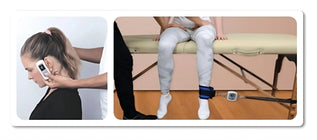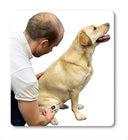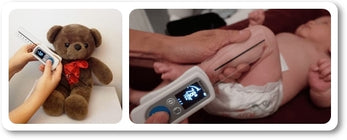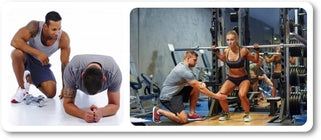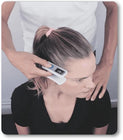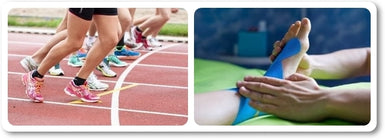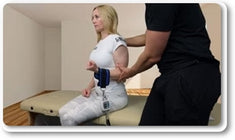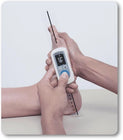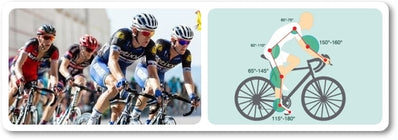New Every Studie
Inter- and intraraterreliability when measuring an elbow joint with the electronic goniometer EasyAngle
Objective
Movements of the elbow joint are essential to be able to perform daily activities or in sports practice. Reliable and standardized measurement methods are therefore important to assess elbow joint mobility. The purpose of this study was to investigate the inter- and intrarater reliability for elbow joint range of motions with the electronic goniometer EasyAngle.

Method
Standardized measurement methods were established. Measurements of active and passive movements of the joint range of motions for the elbow joint were performed by 3 raters (physiotherapists) with varying experience, for flexion, extension, pronation and supination. All measurements were performed twice with approximately 15 minutes between and included in total 21 healthy participants. Participants were recruited through convenience sampling. Exclusion criteria were: ongoing injury in the area, neurological disease that could affect mobility and be younger than 20 years or older than 69 years.
Result
The intraclass correlation (ICC) values for interrater reliability varied between 0.72-0.95 which was classified as good to excellent. For intrarater reliability, ICC values varied between 0.54-0.94 for rater 1, 0.65-0.94 for rater 2 and 0.47-0.94 for rater 3, which was classified as acceptable to excellent.
Conclusion
The inter- and intrarater reliability of the EasyAngle when measuring elbow joint range of motions are considered acceptable to excellent. As our study is the first of its kind for the elbow joint, further research is required with participants from different study populations. More studies are also required that investigate the usefulness of standardization.
Measuring shoulder rotational strength and range of motion: a comprehensive intra-rater, inter-rater and test-retest reliability and validity study of several testing protocols
Objective
Accurate assessment of shoulder range of motion (ROM) and shoulder strength are important aspects in the clinical setting, especially for patient’s status and progression overtime. The purpose of this study was to establish absolute and relative reliability and validity for several procedures measuring the shoulder ROM and strength for internal (IR) and external rotation (ER) with new tools e.g. the EasyAngle and Jamar.

Method
Thirty healthy individuals (15 males, 15 females), with a mean age of 22.3 +/- 1.8 years, were examined by 2 examiners who measured the ROM with a goniometer, inclinometer and the EasyAngle. Secondly the isometric strength was measured with a handheld dynamometer (HHD) and the Jamar in different shoulder positions. Relative reliability was determined by intraclass correlation coefficients (ICC). Absolute reliability was quantified by standard error of measurement (SEM) and minimal detectable change (MDC). The validity was determined by the Pearson correlation coefficient. Systematic differences across trials or between testers, as well as differences among similar measurements under different testing circumstances, were analysed with dependent t-tests.
Result
The intra-rater reliability for the ROM measurements shows excellent results for all the procedures (ICC, 0,931-0,991) but the inter-rater reliability shows low to moderate results (ICC, 0,439-0,774). The reliability for the isometric strength was excellent for all procedures (ICC, 0,843-0,967). For some of the measurements, systematic differences were found across trials or between testers. The subjects position and the equipment resulted in different outcome measurements.
Conclusion
All procedures examined showed acceptable reliability for clinical use. However, the subjects position and equipment might influence the results.
Usability and reliability of a new goniometer tool based on an inertial sensor unit
Objective
The main objective of the study, initiated at CRF La Châtaigneraie Menucourt, is to evaluate the usability of EasyAngle to re-educate and compare metrological qualities to those of the goniometer reference with rotation axis (metallic) and the most commonly used goniometer (plastic)
Assumption is made that the EasyAngle® Goniometer stands out as a more ergonomic tool more reliable and more precise, the graduation of these 2 last goniometers being 2 in 2 °.
As for the smartphone, it has been removed from comparison because it does not meet any criteria hygiene in force in establishments health.

Method
Examiners have previously benefited in training on the use of the EasyAngle, complete with a written guide. The basics of the practice of classical direction finding have been reviewed in order to ensure that in accordance with the original recommendations of Moore to which refers to the work of Norkin et al.
It's through a study of properties metrology that professionals in the field of education were made to use repeated and comparative the Easy Angle device. The objective is to study the reproducibility of measurement and response to the change of the EasyAngle versus the manual reference goniometer (stainless steel, full circle) and the usual goniometer (plastic).
Result
The study involved 55 patients responding to inclusion criteria mentioned above: 30 have been operated on for knee arthroplasty and 25 hip arthroplasty. Twenty physiotherapists and 2 doctors were associated with the metrological study. It's based onb repeated experience with 55 patients that the usability of the device has been appreciated.
The opinion of the 2 doctors was not taken into account in order to rely on a group return homogeneous group of physiotherapists.
Conclusion
At this stage of the data analysis, nothing can not be advanced on the metrological qualities Easy Angle, this device appears obviously attractive and promising for the therapist looking for one measure at a time accurate and fast to collect. Its ergonomics and the gestural economy it induces should limit the risk of error, encourage measurement and traceability.
It remains to demonstrate its metrological qualities which have already been strongly suggested in unfortunately unpublished studies at this day. Exploitation of the results of is in progress.
Link to study online: here.
Assessment of shoulder girdle variables in elite wheelchair athletes and the influence of a 12-week shoulder exercise program
Objective
Development of shoulder pain in athletes with disabilities is a common phenomenon and is multifactorial. The assessment of factors that are associated with shoulder pain is important for diagnosis, treatment progression and to analyse effectiveness of treatment within glenohumeral (GH) disorders and pathologies. Managing shoulder pain in these athletes presents a unique challenge.
The three objectives were: exploring whether elite wheelchair hockey and rugby players exhibit different characteristics of musculoskeletal shoulder-related variables, evaluating the effect of a physiotherapeutic intervention in the hockey team and evaluating the effect of physiotherapeutic intervention in combination with an occupational therapy intervention in the rugby team.

Method
The assessment of range of motion (ROM), muscle strength of the external and internal rotators, scapular position (SP), pectoralis minor length (PML), seated medicine ball throw (SMBT), forward head posture (FHP) and pain pressure threshold (PPT) was performed before and after a 12- week intervention programme. The treatable aspects of the intervention programme were: strength of the rotator cuff (RC), ROM of the GH joint, stretching of the pectoralis minor (PM) and the posterior capsule of the shoulder, self-treatment of myofascial trigger points (MTrPs) by manual pressure and correcting general posture.
Result
The results showed that at baseline, as well as after the intervention, muscle strength of the external rotators was higher within the hockey team. The external rotation (ER)/ internal rotation (IR) ratio and upward rotation of the scapula in 90° of abduction (ABD) was higher for the dominant side within both groups. Upward rotation of the scapula in 0° of ABD was higher on the non-dominant side within the hockey team. Post-intervention the rugby team had more ROM in ER in comparison to the baseline and compared to the hockey team. The SMBT was better post-intervention within the hockey team and the FHP was smaller post-intervention within both groups.
Conclusion
Our intervention programme gives promising results, however, more research is needed. The wheelchair athlete may possibly benefit more from an individual programme over a longer period of time. Other important contributing factors may be accurate information and motivation.
Upper cervical range of rotation during the flexion-rotation test is age dependent: an observational study
Objective
The flexion-rotation test (FRT) is widely used to detect movement dysfunction in the spinal segment C1/C2, especially in patients with cervicogenic headache. The current published literature indicates that range recorded during the FRT is not age dependent. This is questionable, considering the well documented relationship between aging and degeneration in the cervical spine and loss of cervical movement in older people. The present study therefore aims to examine the influence of age on FRT mobility, and to provide normative values for different age groups. An additional aim is to examine the influence of age on the ratio between lower and upper cervical rotation mobility.

Method
For this cross-sectional, observational study, healthy subjects aged from 18 to 90years were recruited. The upper cervical range of rotation during the FRT was measured using a digital goniometer. Personal data including age, weight, height, and lifestyle factors were also assessed.
Result
A total of 230 (124 male) healthy, asymptomatic subjects, aged between 18 and 87years were included. Regression analysis showed that 27.91% (p<0.0001) of the variance in FRT mobility can be explained by age alone, while 41.28% (p<0.0001) of the variance in FRT mobility can be explained by age and total cervical range of motion (ROM). Normative values for different age decades were calculated using regression analysis. No significant influence of age on the ratio between ROM of lower and upper cervical rotation was found. There was no relevant impact of personal (gender, height, and weight) and lifestyle (smartphone and PC use) factors on ROM during the FRT.
Conclusion
Upper cervical rotation mobility determined by the FRT correlates strongly with age; hence, the results of the FRT have to be interpreted taking into account the individual age of the tested subject. The ratio between lower and upper cervical rotation mobility is maintained in all age groups.
Link to study online: here.
Concurrent Validity of Equine Joint Range of Motion Measurement: A Novel Digital Goniometer versus Universal Goniometer
Objective
Goniometry is the measurement of joint angles with a conventional universal goniometer (UG) or a digital goniometer (DG). The UG is validated for use in dogs and cats. However, it demands both of the user’s hands when measuring. To avoid this, a novel type of DG has been developed, simplifying measurement by offering single-hand usage. The objective of this study is to examine the concurrent validity of the DG.

Method
The study consists of measurement with the DG and UG for flexion of the carpus and fetlock on ten horses, and with the DG in flexion and neutral positioning of the fetlock on a sedated horse and corresponding radiographs, intra- and inter-tester reliability and a survey on user-friendliness. The data were analyzed with ANOVA and intraclass correlation coefficient (ICC), with a significance of p < 0.05.
Result
The study showed significant differences in range of motion for the carpus and fetlock joint, a 2–3° difference comparing measurements on a sedated horse with corresponding radiographs, a “fair” to “excellent” inter-tester reliability and a “fair” to “almost perfect” intra-tester reliability, and the DG was easier to use than the UG.
Conclusion
In conclusion, the novel DG may serve as a simple tool for measuring joint motion in equine rehabilitation patients.
Link to study online: here.

